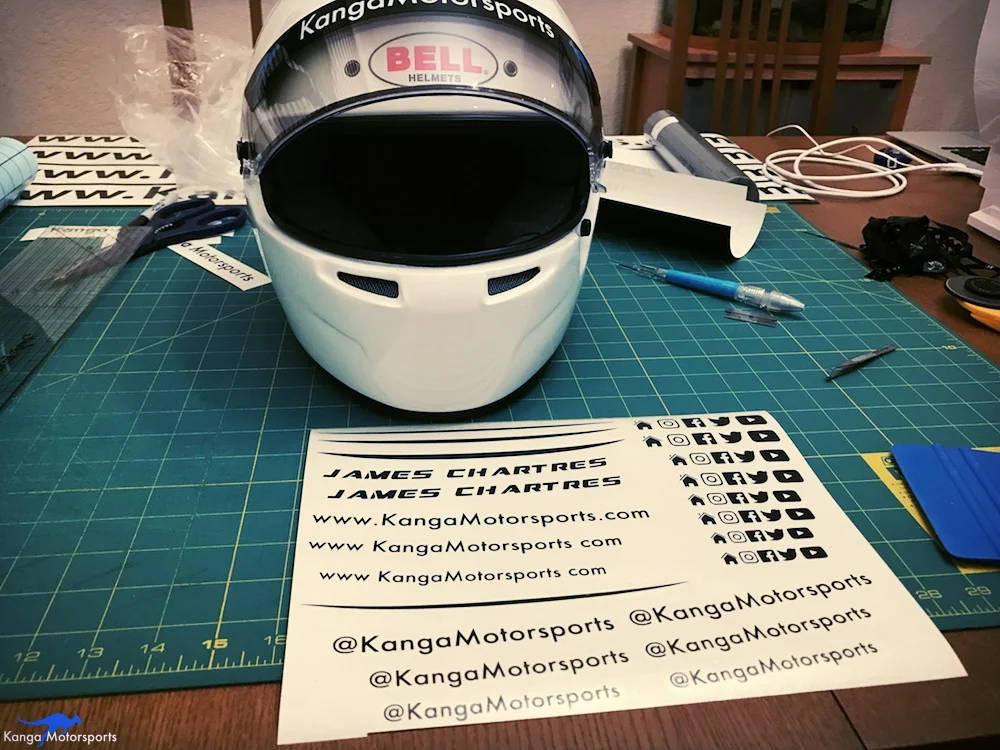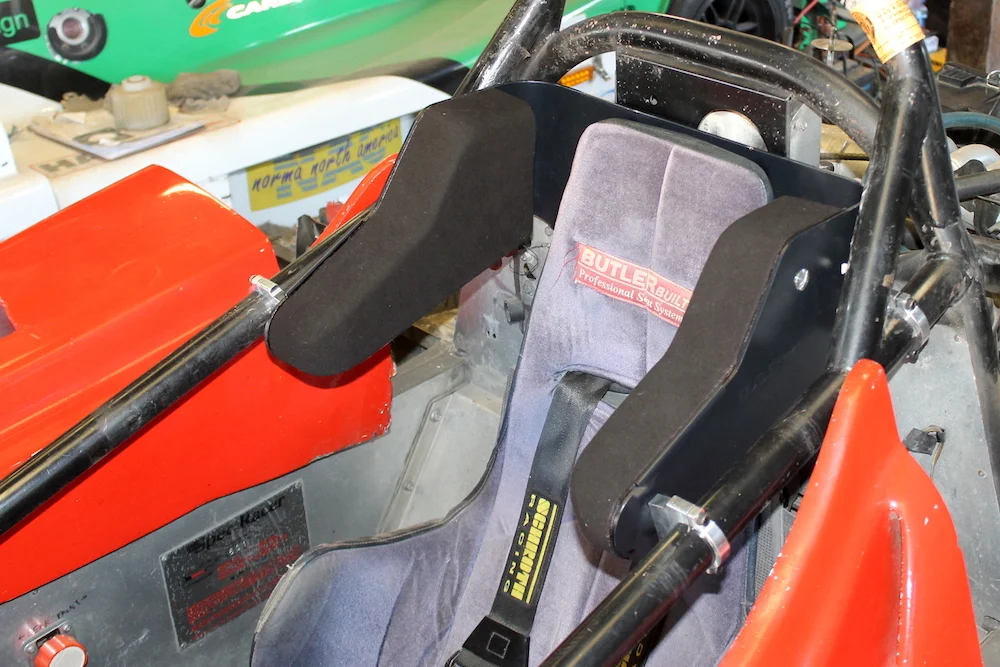In a previous article we discussed installing a radio kit into your helmet. A common question asked by racers is what radios should I buy for my race car? The next question that comes up is what do I need? Inevitably the question becomes Digital versus Analogue radios? In searching for a radio system for the Spec Racer Ford, I decided to learn more by talking to some of the best in business, Shawn Sampson of Sampson Racing Communications. In talking to Shawn, I learned a lot about radio systems and thought I would summarize it here for those looking to upgrade or purchasing their first motorsports radio system.
What does an Amateur Racer need?
The basics of a radio system for the car includes a helmet kit, the in car radio system and a crew radio system. Vendors typically sell full packages or the various kits. You can also buy the specific pieces that you need if you already own other pieces of the kit.
ThE Helmet Kit
The driver helmet kit is pretty straight forward consisting of a microphone, Ear Buds or Helmet Speakers, Radio Connector Cable and then the necessary pieces needed to install the kit into your helmet such as washers, rivets, clamps and mini zip ties. To learn more read our helmet radio install article.
In Car Radio System
The core of the in car radio system is typically a handset for budget racers. High end race cars might have a larger system built into the car. The handset radio is portable and can be moved from car to car, so the racer can take the system with them if they are running in multiple cars or race series. Either way make sure the system is securely mounted so it won't move around while out on track. The most common type of mount is a roll bar box.
Next up is the harness for the car you want to make sure it connects neatly and easily with the driver. A steering wheel mounted push to talk button is great for the driver. The car mounted antenna can improve communications. If endurance racing you might consider extra batteries or optional power harness integrated into the cars electrical system.
Crew Kit
The crew kit can be pretty straight forward with a hand held radio, rubber ducky antenna and a headset. The simplest headset includes a microphone and ear cups speakers with a push to talk button. You can also get basic headsets without microphones so that other crew members can listen to the radio chatter without everyone talking to the driver. More advanced multi-crew radio systems can also be useful on large tracks with spotters.
Digital Radios Versus Analogue
Old style analogue radio systems are starting to be phased out by the next generations of digital radios. Compact 5W digital systems provide better performance and are now more affordable for the amateur or professional racing team.
Advantages
The newer digital systems have improved sound quality and eliminate the static commonly heard on older style analogue radios, see the video. The digital systems also have better coverage without the need for repeaters. As an example many teams running the 25 Hours of Thunderhill with analogue systems would have trouble contacting the driver over the hill on the backside of the track in Turns 7 & 8 but with new digital systems teams have reported crisp clear communications with full track coverage. Analogue radio systems are more susceptible to interference especially on a busy race weekend when a lot radio systems are actively causing RF noise. The digital systems also tend to have better battery life depending on the amount of radio communication. Typical digital hand held systems can last for 6-8 hours. Another advantage of the digital system is that they can not be easily scanned by competing teams due to their encoding.
Disadvantages
The digital systems are a vast improvement over the old analogue technology but, they do have some disadvantages. The tend to be slightly more expensive than a comparable analogue system but this price difference is reducing. Some racing organizations want to be able to listen into the radio communications requiring them to know each teams frequency and encoding rather then using an analogue radio scanner.
Difference Between Manufactures
There are several common manufacturers including Motorola, Uniden,
Vertex and Kenwood with even more coming into the market. The difference between the units tends to be features and price point. Some of the cheaper systems tend to have less features, a shorter battery life and reduced warranty but still provide good coverage. It is recommended you talk to your local motorsports radio specialist and they can set you up with a system to suit your needs. They have the experience and knowledge to know what works at race tracks and which brands perform well and are reliable. Typical budget starter systems can be as low as $600 for the older analogue style and about $800 for a basic digital system. Higher power levels and multi-crew systems can go up to a couple thousand dollars depending on the level of equipment and number of crew members supported.
Common Issues with System Setup
Regardless of how good the radio system is, if it is installed incorrectly it will perform poorly. With modern race cars there are lots of electronics and the engines tend to provide their own sources of RF noise. Make sure the connections are solid and won't come apart even with lots of vibrations and bumps. Avoid having long cable runs with large amounts of looped cables these can act as secondary antennas and result in poor performance. Avoid running the coax cables near larger power sources in the car such as the wiring looms, ignition coils, starter motors and main battery cables. Also Mount the antenna in a high location away from these power sources. A good spot is near the top of the main roll over hoop. One item often over looked by racers is having radios mounted near these high current devices. Prevent corrosion by taking care of your system and not leaving it exposed in the rain.
Summary
Digital system performance is much better than the older style analogue radios. You are better off spending the few extra dollars to get something that works. You can start off with a basic kit and upgrade it if needed but buy the best radios you can get and a good helmet kit for the driver. Nothing is worse than having radios but not being able to understand the driver due to wind noise from a microphone or having poor coverage due to a cheap radio. Custom ear buds, improved crew microphones and extra pit headsets can always be added later. Talk to you local motorsports radio provider about your type of racing and budget, they will help you spec out a system that will work for many years to come.
Big thank you to Sean Sampson of SRC for answering lots of questions and providing the advice needed to write this article.
About Sampson Racing Communications
SRC is a family owned and operated professional racing radios and communications company. They have a vast knowledge and experience with communications drawn from over 45 years of racing across 2 generations. Their extensive knowledge enables them to offer communication systems tailored to your specific needs. SRC maintains a massive inventory of racing radios and accessories enabling them to ship your order same day - including International orders!
Sampson Racing Communications has had the privilege of working with drivers and teams in all forms of Motorsports, including NASCAR, IndyCar, Sports Car Racing, Trans-Am, SCCA, NASA, Rally Racing, Drag Racing, Amateur Endurance Racing, Off Road Racing, Power Boat Racing, Motorcycle Racing, UTV, and of course weekend adventures!



















We decided to replace the old bent and misshaped suspension rockers with the new lighter and stiffer tubular rockers. The step by step guide should make it easier for those attempting the work themselves.